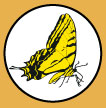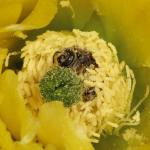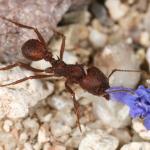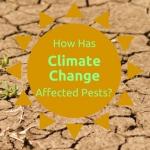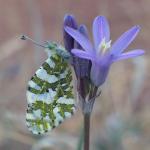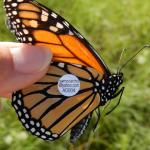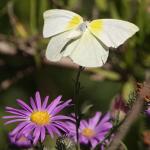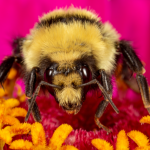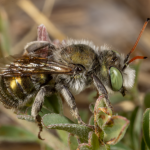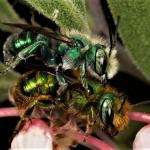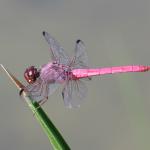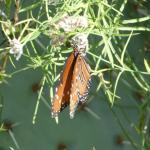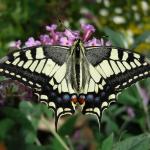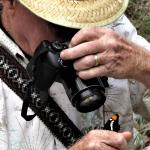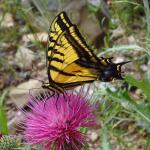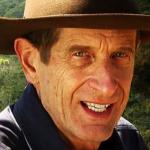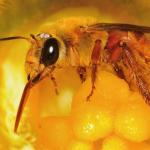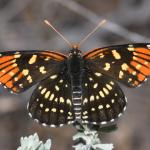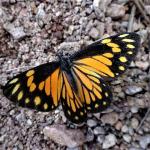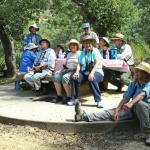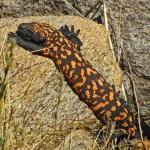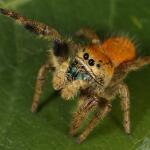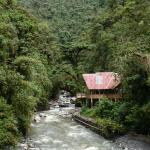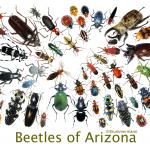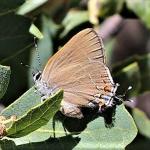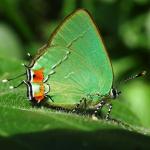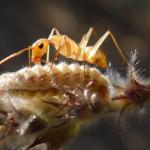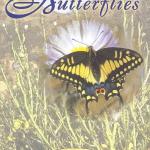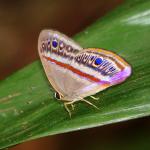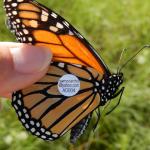Speaker: Jeff Babson
Topic: Tiger Moths
Tiger Moths include some of the most beautiful of all moths, whereas others are quite plain. Think Arizona Sister and Eufala Skipper and you will get the idea. They also have very interesting ecologies regarding host plants, predator avoidance (both larvae and adults), and entomologists have had a difficult time figuring out where the fit in Lepidoptera family tree. Join us for a look at this intriguing group of moths. I know they are not butterflies, but they are close!
Jeff, an ex-SEABA president, always provides an interesting and fun presentation. He currently works for the Pima County Department of Natural Resources, Parks, and Recreation, as the county’s Wildlife Viewing Program Specialist. He also owns Sky Island Tours, an environmental education and eco-tour company, offering programs and tours for birds, butterflies, and dragonflies, among other things."
The link to the recording for this meeting is:
https://us02web.zoom.us/rec/share/_cn2_EpQrgi4_UcSlCqtorFLbqcnh8n92rvBdoJDcXlFAJdx_8mNv33XA7qrxnLO.mXlmYM8cjszCvAdO
Passcode: ?b!h*9f8
Photo © Jeff Babson: Phoenicoprocta hampsonii
Speaker: Kathryn Busby
Topic: Diversity of Native Bees in Arizona
Kathryn Busby is a Ph.D. Candidate in Entomology and Insect Science at The University of Arizona. Previously, she earned Bachelor's degrees in Ecology, Evolution, and Behavior, and Studio Art, from The University of Texas at Austin. She is interested in protecting the diversity of native pollinators, especially bees, through research and science communication and visualization.
The Zoom link is: https://us02web.zoom.us/j/89843525595?pwd=Q2NMaG1pS3kwaktxNmtHYmVLQ1NuQT09
Photo © Karen Busby: Cactus bee in Prickly Pear blossom
Speaker: Jillian Cowles, clinical microbiologist, naturalist, photographer and author of “Amazing Arachnids”
Topic: Partnerships and Betrayal: Plant/Insect Interactions
Insects and plants have been evolving together for over 100 million years. Plants bribe, reward, and sometimes cheat their insect partners, while insects pollinate, protect, cultivate, and sometimes steal from their plant partners. Often the beneficiary of a partnership is an opportunistic third party. Some relationships can be exploitative, in which insects “commandeer” the growth of a plant, forcing it to provide special structures to house the insect’s offspring. Other relationships are true partnerships, so interdependent that neither party can survive without the other. In this presentation we will explore some of the these dramas, featuring a cast of cacti and bees, orchids, ants, and angel trumpets.
If you missed the presentation you can click on the link below to view the Zoom recording of Jillian Cowles' presentation on January 25th!
https://us02web.zoom.us/rec/share/tN3ok0oYARG9Cp8GUJ3ilZE2os3XZmhvw0T9eWSPSVeaxTSAse0YIFCA-HNJk_8K.aC2T7KsqB6x5mjBX
Passcode: 3^ynR6ia
Photo © Jillian Cowles: Leaf cutter ant (Acromyrmex versicolor) gathering a Salvia flower, to use in its underground fungus garden. Leaf cutter ants have been farming far longer than humans (for at least 6 million years), growing fungi to eat.
Speaker:
Topic: October Meeting cancelled. November meeting details will be posted soon.
Unfortunately, our scheduled speaker for the October meeting had to cancel.
Photo: Great Southern White (f) (Ascia monuste) © Gerry Wolfe
Speaker: Shaku Nair
Topic: Climate Change and its Effects on Landscape Pests
Insects and arthropods, being cold-blooded animals, are profoundly affected by climate change; of which temperature, CO2 and humidity might be the three most important weather parameters. The exact impacts of climate change on pests are uncertain. However, climate change is a gradual process and will give us opportunities to modify our practices. The basics of IPM practices such as monitoring, record keeping, and choosing economically and environmentally sound control measures will help us in dealing with the effects of climate change.
Shaku is an entomologist by passion and profession, and experienced in Integrated Pest Management in natural and structural environments. She serves as Associate in Extension – Community IPM at the University of Arizona. Her primary responsibilities include translational research on pest management and community education. Through her program, she addresses pest management questions in a wide variety of community environments such as schools, housing, turf and landscape, recreational areas and medical facilities.
If you missed the presentation you can click on the link below to view the Zoom recording of Shaku Nair's presentation on Tuesday evening!
https://us02web.zoom.us/rec/share/_nav_4oH_x5pP7-9u7ToZchxku2kH1h6p-NWtqFZ6eurYHa9bxJ5b1Nxa9kbd3oz.Y37l-up5GfV9cJKWPasscode: QR5Pry=P
Speaker: Members
Topic: Members photos
It's been a difficult year for butterflies and butterfly photographers! So, unfortunately, there seemed to be too little interest by members and friends to do short presentations of their photos from the past year at next Tueday’s evening zoom meeting, Thus we are sad to say this meeting is now cancelled.
Our next scheduled meeting will be on September 28. Maybe by then will be able to go back to having in person meetings..
In addition, if we get a little rain (you remember: that’s water that falls from the sky!) this monsoon season, maybe we can schedule a few summer butterfly field trips. Keep your fingers crossed.
Photo: Purplish Copper ♀ (Lycaena helloides) © Gerry Wolfe
Speaker: Melissa Mundt, Community Engagement Manager of theTucson Community Gardens
Topic: Nourishing the Pollinators AND the Humans!
Vegetable gardeners sometimes have the single minded goal of producing a bumper crop harvest, but when we expand our vision of a garden to include nourishing the creatures in our Sonoran Desert ecosystem, specifically pollinators, new, and exciting results emerge. Join Melissa Mundt, Community Engagement Manager at Community Gardens of Tucson for an exploration of the relationship between veggie gardens and supporting pollinators and how these strategies can enhance one another.
Melissa Mundt has over 10 years experience with desert gardening, teaching, composting and seed saving. She worked for many years with the Farm and Garden Program of the Community Food Bank of Southern Arizona and recently started a landscape company, Garden PlaySpace, that focuses on kid-friendly gardens and nature play areas. She is a certified Permaculture Designer, certified Smartscape Sustainable Landscape Professional and has training in rainwater harvesting, seed saving, organic food production, backyard chickens and environmental education. She loves home gardening with her 2 young kids, hiking, watercolor painting and power tools.
The link to this Zoom meeting is: SEABA Zoom Meeting Tuesday April 27 at 7:00 PM
Photo: Black Swallowtail caterpillar (Papilio polyxenes) on Fennel (Foeniculum vulgare) © Gerry Wolfe
Speaker: Ken Kingsley
Topic: Endangered Butterflies and other Insects
The U.S. Fish and Wildlife Service currently lists 35 species of butterflies (including skippers) as Threatened or Endangered. How did they get listed? The Monarch was petitioned for listing as Threatened in 2014, but last December the Service came to the conclusion not to list it. Why? What was involved in that decision? I will talk about some of my experience working with Threatened and Endangered butterflies and other insects, review the process of listing species under the Endangered Species Act, and what happened with the Monarch.
Ken Kingsley completed his Ph.D. in Entomology at the University of Arizona in 1985, and has spent most of his career working for SWCA Environmental Consultants and the National Park Service. His work on Threatened and Endangered species of insects has taken him from Hawaiian lava tubes to the Appalachian Mountains, from the prairie of North Dakota to caves of the Edwards Plateau in Texas.
Use the following link to access the recording of this Zoom meeting:
Link to Ken Kingsley's SEABA Zoom presentation
The site will ask for a Passcode which is: #H&nz8F?
Photo: Dakota Skippers (Hesperia dacotae) @ Ken Kingsley
Speaker: Karen LeMay and Bob Behrstock
Topic: Evolution of a Butterfly Garden
Due to COVID-19 restrictions, SEABA is currently holding meetings remotely via ZOOM.
Karen LeMay, founder of Pollinator Corridors Southwest (https://www.pocosouthwest.org/about ) and owner of the one of the best butterfly gardens in Arizona will be presenting “Evolution of a Butterfly Garden” with many plant, butterfly, and other wildlife photos. For the past 17 years, Karen’s yard has evolved from manicured Bermuda grass, to a lush cottage garden for butterflies and then to mostly native plant habitat for wildlife. Karen will be showing Bob’s images of how her butterfly garden in the SE foothills of the Huachuca Mountains has evolved, including some of the 118 species of butterflies seen and the best plants to attract them.
Use the following link to access the recording of this Zoom meeting:
SEABA Feb 23 Butterfly Garden Karen Lemay and Bob Behrstock
Passcode: 38AVrf++
Photo: Pearly Marble (Euchloe hyantis) © Robert A. Behrstock
Speaker: Gail Morris
Topic: Monarchs in Arizona and the Southwest – A Puzzle in Progress
A discussion of recent monarch research in Arizona and the Southwest. Every year, we learn more through the efforts of Community Scientists tagging and monitoring monarchs in our area. She’ll also discuss the recent U. S. Fish and Wildlife monarch status.
Gail Morris is the Coordinator of the Southwest Monarch Study, a Monarch Watch Conservation Specialist and the Vice President of both the Central Arizona Butterfly Association and the Monarch Butterfly Fund.
The link to the zoom meeting is: https://us02web.zoom.us/j/6955760714?pwd=ZWFtOFp6d1ZLL2RpdkNvRG4ydytpQT09
Photo © Gail Morris
Speaker: Gary Jue
Topic: Butterflies in Flight
Please join us on Tuesday evening, November 24 at 7:00PM for a SEABA Zoom meeting presented by our very own Gary Jue, entitled “Butterflies in Flight”. Gary has been taking videos of many of our local butterflies (and other creatures) using his super-fast camera. When these butterfly videos are played back in slow-motion, the results are fantastic and almost unbelievable. See butterflies like you’ve never seen them before.
Gary Jue’s SEABA presentation, “Butterflies In Flight” has been recorded and can be accessed by clicking on this link:
Gary Jue's SEABA Presentation Butterflies in Flight Passcode: N$0IHU^*
Note that if cutting and pasting this passcode doesn’t work at first, please try typing it in directly yourself.
Speaker: Bob Parks
Topic: Through the Seasons with Native Bees, from Northern Colorado to Southern Arizona
We have solved the technical problems we experienced last month that prevented Bob Parks from giving his presentation. Bob Parks, insect photographer extraordinary, will present his beautifully illustrated Through the Seasons with Native Bees, from Northern Colorado to Southern Arizona via Zoom.
The link to Bob's presentation through our SEABA Zoom meeting on Tuesday October 27 at 7:00 PM is:
https://us02web.zoom.us/j/6955760714?pwd=ZWFtOFp6d1ZLL2RpdkNvRG4ydytpQT09.
We recommend that you start to log on to the Zoom meeting a few minutes early. For those of you who are not familiar with Zoom, the following YouTube tutorial https://www.youtube.com/watch?v=9isp3qPeQ0E should be of help to get you started.
Photo: Bombus huntii Queen Summer Fort Collins, Larimer County, Colorado © Bob Parks
Speaker: Bob Parks
Topic: Through the Seasons with Native Bees, from Northern Colorado to Southern Arizona
Since for the near future we can’t have in-person SEABA meeting, we are going start having meetings remotely via Zoom. Our first meeting will be held on Tuesday, September 22 at 7:00PM. Bob Parks, insect photographer extraordinary, will present Through the Seasons with Native Bees, from Northern Colorado to Southern Arizona.
In order to participate in this meeting a Zoom link will be provided later this week. For those of you who are not familiar with Zoom, the following tutorial https://www.youtube.com/watch?v=9isp3qPeQ0E should be of help to get you started.
Photo: Osmia palmula male Spring Cochise County, Arizona © Bob Parks
Speaker:
Topic: Annual Election of Officers will be held via email.
May meeting is cancelled due to Corona virus.The 2020 election of officers will be held electronically.
Photo: Gray Hairstreak ♀ (Strymon melinus)
Speaker:
Topic: MEETING CANCELLED
Speaker:
Topic: Meeting cancelled
Due to concerns about the Coronavirus pandemic, the SEABA Executive Committee has decided to cancel the March 24th meeting. We are sorry to have to do this, but we are working with an abundance of caution and urge everyone to follow the current guidelines for dealing with this pandemic. We hope to be able to reschedule Bob Parks for some time in the fall.
As of this date, the status of the April meeting is uncertain. Please check our website for updates.
Photo: Mating Osmia foxi, Cochise County, AZ © Robert Parks
Speaker: Michael Bogan
Topic: Dragonflies and Damselflies of the lower Santa Cruz River
Join Michael Bogan, an aquatic ecologist and assistant professor in the School of Natural Resources and the Environment at the U of A, to learn about the wonderful world of Odonata in our local effluent-dependent river! Despite its rough history of stream drying and poor water quality, the Santa Cruz River is now thriving again thanks to treatment plant upgrades and environmental flow releases. These effluent-dependent reaches support a diverse and beautiful assemblage of dragonflies and damselflies in our city, and new species continue to be documented from the river.
Photo: Roseate Skimmer (Orthemis ferruginea) © Michael Bogan
Speaker: Margarethe Brummermann
Topic: Pollination
200 million years ago before there were flowering plants, the vast majority of pollination was wind enabled. Plants with beautifully colored flowers, many with pleasing fragrances and providing nectar and pollen started to evolve to attract animal pollinators. This included mammals, birds and especially insects which co-evolved to become the main pollinators today. Margarethe will illustrate how flowers adapted many strange and interesting strategies to entice and sometimes trick these animal vectors into providing pollinating services.
Margarethe is a biologist, watercolor painter, and photographer originally from Germany where she received her M.S. and Ph.D. in Biology. She is currently associated with the Entomology Department of the University of Arizona and is working on producing a photographic field guide to Arizona beetles with co-author Arthur Evans. For this purpose she has collected, identified and photographed (live) over 1800 Arizona Beetle species.
Painting of Sacred Datura & Sphinx moths © Margarethe Brummerman
Speaker: Andy Hogan
Topic: Counting Butterflies at Tohono Chul
Andy Hogan, a 13-year docent at Tohono Chul, enlisted SEABA's help in creating a butterfly checklist and then helping to train the first docents to lead butterfly tours. He has been counting butterflies at Tohono Chul weekly (mostly) for the last 5+ years. These counts show large changes in butterfly abundance in general (down) and Monarchs (up) by season and weather conditions.
Speaker: Margarethe Brummermann
Topic: The Pollinators
Speaker: Carl Olson
Topic: Insects from Far and Wide
Join Carl Olson, former Associate Curator for the Entomology Department at the U of A and celebrated raconteur of all things ‘bugs’ as he takes us on a virtual trip far and wide to meet some of the unusual insects. You simply have to be on hand as Carl relates the interesting story of Ball's Pyramid 'Tree Lobster' seen to the left in Carl’s photo.
Speaker: SEABA members
Topic: Annual Election of Officers and Member's Photos meeting
Many SEABA members are accomplished photographers, so at the May meeting SEABA invites its members to share a few of their own memorable butterfly images from past trips and outings.
SEABA will hold its annual election of officers at the May meeting.
Speaker: Jillian Cowles
Topic: Down the Rabbit Hole: Arachnids in an Arizona Wonderland
Since completing her education in biologist in Arizona, Jillian’s vocation has been working as a clinical microbiologist in a hospital, and her avocation has been to learn about the plants and animals in this region, its indigenous people, their history, and how they have incorporated native resources into their lives. She started photographing spiders, and the rest is history. For over ten years, she has been documenting the diversity and natural history of the arachnids of the southwestern United States, and has written a book, Amazing Arachnids, published by Princeton University Press.
Photo © Jillian Cowles
Speaker: Priscilla Brodkin
Topic: Butterflies of SE AZ: A Photographic Guide
Join Priscilla for a virtual butterfly field trip through the seasons of the year! emphasis on ID, food and nectar plants. Just in time to plant your butterfly garden & watch SE AZ fantastic pollinators in action! Priscilla has been a butterfly finder and photographer for many years, and is the co-author of Butterflies of AZ: A Photographic Guide. She was one of the founding members of SEABA, back in 1999. Her presentations from her amazing trips to see butterflies in various tropical locations in South America have always been very popular.
Two-tailed Swallowtail (Papilo multicaudata) Photo © Priscilla Brodkin
Speaker: David Yetman
Topic: A short guide to why I like deserts so much
Since 2000, David has been featured in the PBS Series ‘The Desert Speaks” and "In the Americas with David Yetman". Yetman received his bachelor’s, master’s and doctoral degrees in philosophy from the University of Arizona. Since 1992, he served as a research social scientist at the UA’s Southwest Center, researching the state of Sonora, its indigenous people, their history, and how they have incorporated native resources into their lives.
Speaker: Bob Parks
Topic: Amazing Insects
Spend an evening learning about some amazing insects with Bob Parks. Bob is a field associate at the San Diego Natural History Museum in the entomology department and has studied entomology for over fifty years.
Photo: Xenoglossa species, a common nocturnal bee. Hereford Arizona © Bob Parks
Speaker: Ken Kertell
Topic: Remembering 2018
SEABA member and accomplished photographer Ken Kertell will show images of his favorite butterflies from a variety of destinations, including Panama, Sonora Mexico, and the western USA. Ken used to work for a living, but now he travels and photographs butterflies in the Americas.
Photo: Leanira Checkerspot (Chlosyne leanira leanira) © Ken Kertell
Speaker: Jeff Babson
Topic: Small Carnivores
Jeff Babson's illustrated talk will focus on the skunks, foxes, and other (relatively) small mammals placed in the order Carnivora. Jeff is the owner of Sky Island Tours, which features field trips for birds, butterflies, dragonflies, and general natural history. He is also the Wildlife Program Specialist for Pima County Department of Natural Resources, Parks, and Recreation and is a past president of SEABA.
photo: Common Gray Fox (Urocyan cinereoargenteus)
Speaker: Priscilla Brodkin
Topic: Beautiful Butterflies of SE Arizona
Join us for a virtual butterfly field trip in SE Arizona from Spring to Fall with SEABA Treasurer Priscilla Brodkin. Birders and Naturalists, add a new dimension to your field experience with Butterflies flying midday!
female Chiracahua White (Neophasia terlootii) photo © Priscilla Brodkin
Speaker: Three or Four SEABA Members
Topic: Annual Election of Officers and Members Photographs Night
Many SEABA members are accomplished photographers, so every year at the May meeting SEABA invites its members to share a few of their own memorable butterfly images from past trips and outings.
SEABA will hold its annual election of officers at the May meeting.
SEABA Field Trip group photo © Larry Fellows
Speaker: Larry Jones
Topic: Venomous Creatures of the Southwest!
Biologist & author Larry Jones will showcase his passion for venomous scorpions, centipedes, wasps, assassin bugs, caterpillars, reptiles, shrews, etc. Also: “What is it like to be envenomated?”
Gila Monster (Heloderma suspectum), photo © by Larry Fellows
Speaker: Ken Kertell
Topic: Exquisite Butterflies of Lago Soledad, Peru
Join Ken for his stunning photographic examination of butterflies in primary rainforest in the remote and largely unstudied Las Piedras River basin.
Symmachia pardalis photo © Ken Kertell
Speaker: Jillian Cowles
Topic: Amazing Arachnids in Southern Arizona
Arachnids have survived 400 million years of a changing planet. Our desert has presented some special challenges, selecting for extraordinary solutions and fantastic creatures.
Included in this talk will be a sampler of interesting inhabitants, among them sand spiders, Arizona brown spiders (related to the notorious brown recluse), jumping spiders, spitting spiders, scorpions, pseudoscorpions, wind spiders, vinegaroons, andgiant desert velvet mites. We are incredibly lucky to be living insuch a hotspot of interesting arachnids.
Phidipus sp. (spider) photo © Jillian Cowles
Speaker: Jim Brock, author of “Butterflies of North America”
Topic: 20 Years of Backyard Butterflying and The World's Best Butterflying Spot
Join Jim Brock, author of “Butterflies of North America”, as he takes us on a virtual tour stretching from his world class backyard butterfly garden in Tucson to the rain forest of Peru.
SE Peru Cloud Forest photo © Jim Brock
Speaker: Margarethe Brummermann
Topic: Beetles of Arizona
There are almost 350,000 species of beetles on Earth. This is one-third of all of the animal species on planet. Beetles, as our butterflies, go through complete metamorphosis from egg to larva (grub) to pupa and then finally adult. They have many interesting and diverse survival strategies. Please join biologist, artist and photographer Margarethe Brummermann as she showcases her favorite insects from the more than 1000 species of beetles she has photographed in Arizona.
Beetles of AZ image by Margarethe Brummermann
Speaker: Bill Beck
Topic: Arizona’s Hairstreaks Overview
Join us for a presentation on the varieties of hairstreaks we have in Arizona and where they live. Included in the presentation will be some discussion on why we might have what we do (bio- or paleogeography), reference and information on hairstreak taxonomy and its insight into evolutionary changes, and information on aspects and studied characters of these butterflies that may (or may not) be in the literature.
Ilavia Hairstreak (Satyrium ilavia) photo by Bill Beck
Speaker: Priscilla Brodkin, SEABA Treasurer
Topic: BOLIVIA: Butterflies, Birds, Snakes & Socialism
See the beautiful nature of Bolivia from the high Andes of La Paz to the rivers of Cochabamba to lowland Santa Cruz, all seen through the eyes of an enthusiastic butterfly & bird photographer. South America's poorest country has natural wonders that are unbelievable to behold!
Hairstreak (Erora opisena) photo by Hank & Priscilla Brodkin
Speaker: Larry Fellows, SEABA President, and other members
Topic: Annual Election of Officers and Members Photographs Night
Many SEABA members are accomplished photographers, so every year at the May meeting, SEABA invites its members to share a few of their own memorable butterfly images from past trips and outings.
SEABA will hold its annual election of officers at the May meeting.
Speaker: Karen Nickey and Sharon Overstreet, SEABA Members
Topic: 2016 NABA Annual Meeting, Mission, TX
The National Butterfly Center (NABA's headquarters in Mission TX,) hosted the Texas Butterfly Festival October 29th through November 1, 2016, prime butterfly season in the Lower Rio Grande Valley (LRGV), where the river winds its way toward the Laguna Madre at the Gulf of Mexico. This unique region encompasses no fewer than 11 different types of habitat, from tidal wetlands to riparian forest, brushland scrub to prairie savanna, and is home to more than 1,200 different species of plants, 500 species of birds, 200 vertebrate species, roughly 300 species of butterflies, and over 90 species of dragonflies!
Please join some of your fellow SEABA members who experienced the festival, visited private gardens and many 'hot spot' sites; Karen Nickey, a past president of SEABA, as well as a former Sabino Canyon Butterfly Count compiler, will narrate the presentation and share experiences and photos of the butterflies, flora and fauna enjoyed throughout the festival.
Speaker: Dick and Pat Carlson
Topic: Butterflies & Birds in Venezuela
Join Dick and Pat as they share their images of birds, butterflies, and culture from traveling in Cuba and a remote lodge in Venezuela.
Speaker: Kim Franklin, AZ-Sonora Desert Museum
Topic: Amazing Ants in the Sonoran Desert
Photo: Ant tending Reakirt's Blue caterpillar © Fred Heath
Speaker: Elaine Halbedel, SEABA Member/Traveler
Topic: The Best of the Best: Butterflies from Around the World
No Little Brown Skippers here! Let’s look at the pictorial highlights from 4 recent trips to diverse parts of the world: Panama, SE Ecuador, southern Africa, and Indonesia. The emphasis will be on the rarest and most colorful butterflies that these parts of the world can offer. And of course, there might be a few other types of creatures: Ever wonder how fast a motivated Komodo Dragon can move? And whether elephants really do mourn their dead?? How about a moth that looks like it was spawned in another galaxy???
Speaker: Rich Bailowitz, Entomologist and Birder
Topic: Damselflies and Dragonflies of Arizona & Sonora
Join one of the coauthors of the recently published "A Field Guide to the Damselflies & Dragonflies of Arizona and Sonora" for this informative and sometimes humorous presentation.
Speaker: Katy Prudic, UA Dept. of Entomology
Topic: How a Butterfly Gets its Spots: Development and Ecology of Wing Patterns
Speaker: Charles Melton, Nature Photographer
Topic: Moths: The other Lepidoptera
This was an opportunity to learn about grassland restoration and its impact on butterflies and caterpillars. Jim is the Nursery Director for Desert Survivors, Inc, an associate researcher at the University of Arizona herbarium, and he is interested in field botany, local floristics, plant/insect relationships, and research.
Speaker: Kathleen Purdic, Ph.D. and SEABA Members
Topic: eButterlfly, Members Potpourri, and Annual Election of Officers
Katy earned her doctoral degree in Evolution and Ecology from the University of Arizona. She is co-director of eButterfly, an online repository for sharing butterfly photos and checklists, and a resource to see which butterflies are flying across North America. She shared her butterfly adventures regarding eButterfly, conservation, and the role of citizen science in scientific discovery.
Many SEABA members are also accomplished photographers, so every year at the May meeting, SEABA invites its members to share a few of their own memorable butterfly images from past trips and outings.
SEABA also held its annual election of officers at the May meeting.
Speaker: Jim Verrier, Desert Survivors, Inc.
Topic: The myths and realities of grassland restoration in SE Arizona and its impact on butterflies and caterpillars
Here is an opportunity to learn about grassland restoration and its impact on butterflies and caterpillars. Jim is the Nursery Director for Desert Survivors, Inc, an associate researcher at the University of Arizona herbarium, and he is interested in field botany, local floristics, plant/insect relationships, and research.
Please join us for an interesting evening with Jim Verrier!
Speaker: Fred Heath
Topic: Southern California Endemic Butterflies
In 2004, Fred authored "An Introduction to Southern California Butterflies" with photographs by the late Herb Clarke. As in writing any book, Fred learned much about California butterflies and what makes them special. One of the things about California is that there are over 30 butterfly species which are endemic or near endemic to the state. No other state comes close. Please join Fred as he takes you on an illustrated tour to see these unique butterflies through the seasons of southern California with the wonderful photographs of Herb Clarke. Fred will also have on hand copies of his book to autograph and sell with $5 of the $20 purchase price going to support SEABA.
Speaker: Priscilla Brodkin
Topic: Peru's River of Butterflies; Tambopata & Manu Reserves
This presentation was an opportunity to explore the Amazon rainforests of Peru with Hank and Priscilla Brodkin, as they searched for endemic butterflies, birds, and even a jaguar. Priscilla lives in Carr Canyon, AZ, surrounded by the natural biodiversity of the Huachuca Mountains. Avid birders for most of their lives, they became butterfly enthusiasts in 1992. Their birding trips to Latin America turned into butterfly trips ranging from the Andes to the Amazon basin where they photographed thousands of butterflies, birds, and other interesting creatures. In 2001, they co-authored "Butterflies of Arizona, a Photographic Guide" with Bob Stewart. Hank also co-authored "Finding Butterflies in Arizona" with Rich Bailowitz, published in 2009.
Photo by Priscilla and Hank Brodkin
Speaker: Jeff Babson
Topic: Moths of Southern Arizona
Moths are the under-appreciated, usually nocturnal cousins of butterflies. Yet moths greatly outnumber butterflies and many rival butterflies in their beautiful colors and patterns. This presentation will introduce you to these remarkable insects.
Jeff Babson is a life long naturalist with a particular interest in birds, butterflies, moths, beetles and dragonflies. He owns Sky Island Tours, an environmental education and eco-tour company. He has led birding tours for Pima County Department of Natural Resources, Parks, and Recreation, Arizona-Sonora Desert Museum, Tucson Botanical Gardens, and several birding festivals in southern Arizona (Wings over Willcox, Southwest Wings, Tucson Birding and Nature Festival). He has also taught classes and led field trips for butterflies, moths, dragonflies, and beetles. He lives in Vail with his wife and two children.
Please come and enjoy "Moths of Southern Arizona" presented by Jeff Babson
Speaker: Larry Fellows
Topic: The Ice Age and the Western Giant Swallowtail: A Geologic Perspective
Larry was born and raised in Iowa. He earned a Bachelor’s degree in geology from Iowa State University, a Master’s degree from the University of Michigan, and a PhD from the University of Wisconsin. Later he was appointed as Director of the Arizona Geological Survey (a State agency headquartered in Tucson) and Arizona’s State Geologist in 1979. He served in this position for 26 years before retiring in 2005. Larry has 40+ years of photography experience and is currently serving on SEABA’s board of directors.
Photo by Larry Fellows
Speaker: Gail Morris
Topic: Status of Monarch Butterflies (Danaus plexippus) in Arizona
Gail coordinates the Southwest Monarch Study and is the Monarch Watch Conservation Specialist for Arizona and the West. She is also the Vice President of the Monarch Butterfly Fund. She has been involved with Monarchs for many years and shared with us some of her vast knowledge and most recent Danaus plexippus study findings.
Photo by Gail Morris
